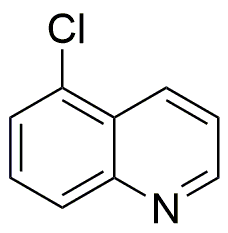5-Chloroquinoline is widely utilized in research focused on:
- Pharmaceutical Development: This compound serves as a key building block in the synthesis of various pharmaceuticals, particularly in the development of anti-malarial and anti-cancer drugs, enhancing therapeutic efficacy.
- Agricultural Chemicals: It is used in the formulation of agrochemicals, including fungicides and herbicides, providing effective solutions for pest management in crops.
- Fluorescent Dyes: 5-Chloroquinoline is employed in creating fluorescent dyes, which are essential in biological imaging and diagnostics, allowing for better visualization of cellular processes.
- Research in Biochemistry: This compound is utilized in biochemical research to study enzyme interactions and metabolic pathways, offering insights into cellular functions and disease mechanisms.
- Material Science: It finds applications in the development of advanced materials, such as polymers and coatings, which benefit from its unique chemical properties, enhancing durability and performance.
General Information
Properties
Safety and Regulations
Applications
5-Chloroquinoline is widely utilized in research focused on:
- Pharmaceutical Development: This compound serves as a key building block in the synthesis of various pharmaceuticals, particularly in the development of anti-malarial and anti-cancer drugs, enhancing therapeutic efficacy.
- Agricultural Chemicals: It is used in the formulation of agrochemicals, including fungicides and herbicides, providing effective solutions for pest management in crops.
- Fluorescent Dyes: 5-Chloroquinoline is employed in creating fluorescent dyes, which are essential in biological imaging and diagnostics, allowing for better visualization of cellular processes.
- Research in Biochemistry: This compound is utilized in biochemical research to study enzyme interactions and metabolic pathways, offering insights into cellular functions and disease mechanisms.
- Material Science: It finds applications in the development of advanced materials, such as polymers and coatings, which benefit from its unique chemical properties, enhancing durability and performance.
Documents
Safety Data Sheets (SDS)
The SDS provides comprehensive safety information on handling, storage, and disposal of the product.
Product Specification (PS)
The PS provides a comprehensive breakdown of the product’s properties, including chemical composition, physical state, purity, and storage requirements. It also details acceptable quality ranges and the product's intended applications.
Certificates of Analysis (COA)
Search for Certificates of Analysis (COA) by entering the products Lot Number. Lot and Batch Numbers can be found on a product’s label following the words ‘Lot’ or ‘Batch’.
*Catalog Number
*Lot Number
Certificates Of Origin (COO)
This COO confirms the country where the product was manufactured, and also details the materials and components used in it and whether it is derived from natural, synthetic, or other specific sources. This certificate may be required for customs, trade, and regulatory compliance.
*Catalog Number
*Lot Number
Safety Data Sheets (SDS)
The SDS provides comprehensive safety information on handling, storage, and disposal of the product.
DownloadProduct Specification (PS)
The PS provides a comprehensive breakdown of the product’s properties, including chemical composition, physical state, purity, and storage requirements. It also details acceptable quality ranges and the product's intended applications.
DownloadCertificates of Analysis (COA)
Search for Certificates of Analysis (COA) by entering the products Lot Number. Lot and Batch Numbers can be found on a product’s label following the words ‘Lot’ or ‘Batch’.
*Catalog Number
*Lot Number
Certificates Of Origin (COO)
This COO confirms the country where the product was manufactured, and also details the materials and components used in it and whether it is derived from natural, synthetic, or other specific sources. This certificate may be required for customs, trade, and regulatory compliance.


